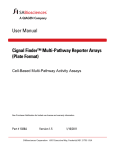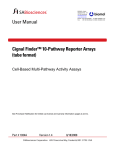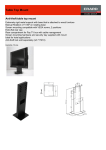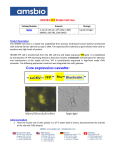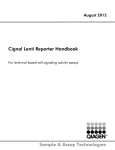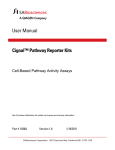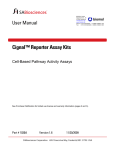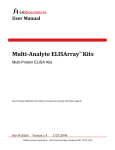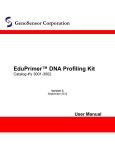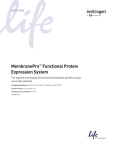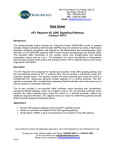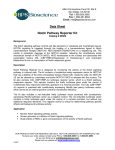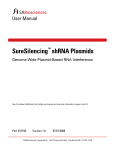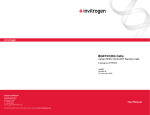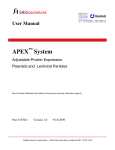Download User Manual
Transcript
User Manual Cignal Finder™ 10-Pathway Reporter Arrays (tube format) Cell-Based Multi-Pathway Activity Assays See Purchaser Notification for limited use license and warranty information (pages 2 and 3). Part # 1034A Version 1.5 1/10/2011 ™ Cignal Finder 10-Pathway Reporter Arrays (tube format) Cell-Based Multi-Pathway Activity Assays User Manual (For Catalog Numbers CCA-00#L) Ordering and Technical Service Contact Information: Tel: Fax: On-line Order: E-MAIL: 1-888-503-3187 (US) 301-682-9200 (outside US) 1-888-465-9859 (US) 301-682-7300 (outside US) www.SABiosciences.com [email protected] (to place an order) [email protected] (for technical support) You may place orders by fax, e-mail or from our website. Each order should include the following information: Your contact information (name, phone, email address) Product name, catalog number and quantity Purchase order number or credit card information (Visa or MasterCard) Shipping address Billing address For more information, visit us at www.SABiosciences.com SABiosciences Corporation 6951 Executive Way, Suite 100; Frederick, MD 21703; USA 2 CONTENTS I. Introduction 4 II. Product Contents and Descriptions 6 III. Additional Materials Required 9 IV. Protocol 10 A. Before you begin 10 B. Generalized Transfection Protocols 11 C. Co-transfection Protocol for siRNA + Reporter Assay 13 D. Co-transfection Protocol for shRNA + Reporter Assay 15 E. Co-transfection Protocol for Expression Vector + Reporter Assay 17 F. Transfection and Treatment Protocol for Reporter Assay + Small Molecules/Organic Compounds 20 G. Transfection and Treatment Protocol for Reporter Assay + Peptide/Recombinant Protein 23 H. Scaling up Transfection Experiments 26 Appendix: Cignal Finder 10-Pathway Array Product Descriptions Technical Support: [email protected] 3 27 www.SABiosciences.com TM Cignal Finder Reporter Arrays (tube format) I. Introduction The Cignal Finder 10-Pathway Reporter Arrays enable you to pinpoint the pathways regulated by the gene products or chemical compounds being studied in your laboratory. The Cignal Finder Arrays consist of 10 dual-luciferase reporter assays, and are designed for use in one of four research areas. The targeted research areas are cancer, immunology, development, and toxicology. In this era of post-genomics life science research, many labs are investigating how diverse signal transduction pathways function on their own, and in combination, within the cell. The Cignal Finder Arrays equip life science researchers to carry out such studies with speed and confidence. The arrays are delivered in 12-tube strips, including important negative and positive controls. The assays are used right out of the box for the transfection or reverse transfection of the reporter assays into your cell lines of interest. The Cignal Finder Reporter Arrays are valuable tools for progressing from the identification of genes, proteins, or small molecules to understanding their function. Each pathway-focused dual-luciferase reporter encodes for the mammalian codonoptimized, non-secreted form of the firefly luciferase gene, carrying a protein-destabilizing sequence. Cells rapidly degrade the destabilized form of the firefly luciferase protein and hence the background luciferase activity (noise level) is greatly reduced. Due to low background activity, the magnitude of the response that can be measured (signal-to-noise ratio) as well as the speed of measuring changes in transcription are enhanced. The Cignal dual-luciferase reporter assays provide outstanding reproducibility, sensitivity, specificity, and signal-to-noise ratio. They are extremely useful assays for carrying out quantitative pathway regulation studies. Benefits of Cignal Finder 10-Pathway Reporter Arrays BIOLOGICAL PROCESS-FOCUSED: Profile the changes in the activities of ten signaling pathways relevant to a specific biological process HIGH PERFORMANCE: Dual-luciferase assay provides high sensitivity, specificity, and reproducibility FLEXIBILITY AND CONVENIENCE: Utilize a straightforward traditional transfection or reverse transfection procedure with your favorite cell lines to rapidly generate valuable mechanism of action data Available Cignal Finder 10-Pathway Reporter Arrays (tube format) Product Name Cignal Finder Cancer 10-Pathway Reporter Array Cignal Finder Development 10-Pathway Reporter Array Technical Support: [email protected] 4 Catalog Number CCA-001L CCA-003L www.SABiosciences.com Version 1.5 Figure 1: Overview of Cignal Finder™ Reporter Array (tube format) Process. Technical Support: 888.503.3187 (US) 5 301.682.9200 TM Cignal Finder Reporter Arrays (tube format) II. Product Contents and Descriptions A. Cignal Finder 10-Pathway Reporter Array Contents: Table 1: Cignal Finder Reporter Array (tube format) Specifications Component Concentration and total volume Specification A mixture of an inducible transcription factor Each of the responsive firefly luciferase reporter and (100 ng/l; 100 µl) 10 Reporter constitutively expressing Renilla construct Assays (40:1). Negative control Positive control A mixture of non-inducible firefly luciferase reporter and constitutively expressing (100 ng/l; 100 µl) Renilla construct (40:1). A mixture of a constitutively expressing GFP construct, constitutively expressing firefly (100 ng/l; 100 µl) luciferase construct, and constitutively expressing Renilla luciferase construct (40:1:1). NOTE: These constructs are transfection-grade and are ready for transient transfection. These constructs are specifically designed to inhibit transformation and are NOT MEANT for introduction and amplification in bacteria. Each Cignal Finder 10-Pathway Reporter Array includes the following components: Tubes 1 to 10 contain 10 different Cignal Pathway Reporters (100ng/µl; 2 X 50 µl) Tube 11 contains Cignal Reporter Assay negative control (100ng/µl; 2 X 50 µl) Tube 12 contains Cignal Reporter Assay positive control (100ng/µl; 2 X 50 µl) Each strip is numbered from 1 to 12. Please refer to the specific Cignal Finder Array product specification sheet for the identity of each individual reporter assay in that array. The strip cap used for each 12-tube strip has a tab attached to the cap for tube #1. This assists you in maintaining the caps in the proper orientation. Technical Support: [email protected] 6 www.SABiosciences.com Version 1.5 B. Description of Individual Cignal Reporter Assays: Each Cignal Reporter Assay Kit includes the following components: 1. Reporter: Each reporter is a mixture of an inducible transcription factor responsive construct and constitutively expressing Renilla luciferase construct (40:1). The inducible transcription factor-responsive construct encodes the firefly luciferase reporter gene under the control of a basal promoter element (TATA box) joined to tandem repeats of a specific Transcriptional Response Element (TRE; Figure 2A). This construct monitors both increases and decreases in the activity of a key transcription factor, which is a downstream target of a specific signaling pathway. The constitutively expressing Renilla construct encodes the Renilla luciferase reporter gene under the control of a CMV immediate early enhancer/promoter (Figure 2B) and acts as an internal control for normalizing transfection efficiencies and monitoring cell viability. It is also useful to confirm transfection and to verify active luciferase in the transfected culture. 2. Negative control: The negative control is a mixture of non-inducible reporter construct and constitutively expressing Renilla luciferase construct (40:1). The noninducible reporter construct encodes firefly luciferase under the control of a basal promoter element (TATA box), without any additional transcriptional response elements (Figure 2C). The negative control is critical to identifying specific effects and determining background reporter activity. 3. Positive control: The positive control is a constitutively expressing GFP construct (Figure 2D), pre-mixed with a constitutively expressing firefly luciferase construct (Figure 2E), and a constitutively expressing Renilla luciferase construct (Figure 2B) (40:1:1). The positive control is necessary for visual confirmation of transfection. It is also useful for transfection optimization studies. The expression of the GFP from the positive control construct can be monitored by fluorescence microscopy using an excitation filter of 470 ± 20 nm (470 / 40 nm) and an emission filter of 515 nm (long pass). Technical Support: 888.503.3187 (US) 7 301.682.9200 TM Cignal Finder Reporter Arrays (tube format) A. Tandem repeats of TREs B. TATA box Firefly Luc CMV immediate early enhancer/promoter Renilla Luc TATA box C. Firefly Luc D. CMV immediate early enhancer/promoter MGFP E. CMV immediate early enhancer/promoter Firefly Luc Figure 2: Schematic representation of constructs involved in the Cignal Reporter Assay. (A) The inducible transcription factor-responsive construct expressing firefly luciferase, (B) The constitutively expressing Renilla luciferase construct, (C) The noninducible firefly luciferase reporter construct, (D) The constitutively expressing GFP construct, and (E) The constitutively expressing firefly luciferase construct. Technical Support: [email protected] 8 www.SABiosciences.com Version 1.5 III. Additional Materials Required: Mammalian cell line cultured in the appropriate growth medium Cell culture medium and standard cell culture supplies 96-well tissue culture plates Multi-channel pipettor and pipettor reservoirs Transfection reagent [We recommend SureFECT (SABiosciences, Cat. No. SA-01), however, other transfection reagents work equally well] Polystyrene test tubes (BD FALCON, Cat # 352099) Opti-MEM® I Reduced Serum Medium (Invitrogen, Cat. No. 31985-062) Fetal bovine serum (FBS) Non-essential amino acids (NEAA) (Invitrogen, Cat. No. 11140-050) Penicillin/Streptomycin Hemacytometer Dual-Luciferase® Assay System o Dual-Luciferase® Reporter Assay System (Promega, Cat. No. E1910) This system requires cell lysis, and is well-suited for the rapid quantitation of both luciferase reporters when using luminometers with reagent auto-injectors. o Dual-Glo® Luciferase Assay System (Promega, Cat. No. E2920) This system is used to assay for both luciferase reporters on intact cells in growth medium. This system can be used with any luminometer, including those without reagent auto-injectors. 96-well white opaque flat bottom microtiter plate Luminometer Technical Support: 888.503.3187 (US) 9 301.682.9200 TM Cignal Finder Reporter Arrays (tube format) IV. Protocol: A. Before you begin: 1. Cell line selection: The Cignal Reporter Assay may be used with various mammalian cell lines. Cell lines show a great deal of variation in the levels of signaling proteins. The transcriptional activator activities in the cell line used will determine the sensitivity of the assay. A cell line should be selected based on the functionality of the signal transduction pathway under investigation, as well as for the “transfectability” of the cell line (see below). 2. Transfection reagent selection: We recommend the use of SureFECT (SABiosciences, Cat. No. SA-01) as a transfection reagent. The Cignal Reporter Assay, however, also performs equally well with other transfection reagents such as Lipofectamine 2000 (Invitrogen, Cat. No. 11668-027), or FuGENE 6 (Roche, Cat. No. 1815091). When using alternative transfection reagents, please refer to the manufacturer’s instructions on the use of those reagents. 3. Optimization of transfection conditions: The sensitivity of the Cignal Reporter Assay depends on the transfection efficiency. The transfection efficiency, in turn, primarily depends upon cell line used. Therefore, it is very important to optimize the transfection conditions for each cell type under study. Variables to consider, when optimizing the transfection conditions include cell density, cell viability, amount of DNA, ratio of DNA to transfection reagent, transfection complex formation time, and transfection incubation time (see the detailed protocols for our recommendations). The positive control construct included with each Cignal Reporter Assay can be used for determining the optimal transfection conditions. 4. Optimization of assay condition: The response rate in the Cignal Reporter Assay depends on the assay conditions (conditions of the experimental treatment). To obtain maximum response given by any stimulus, perform dosing and time-course studies. The optimal amount of stimulus and the time of treatment must be obtained empirically for each experiment (see different protocols for our recommendations). 5. Important recommendations for best results: A. Perform all transfections in triplicate to minimize variability among treatment groups. B. Include positive and negative controls in each experiment to obtain reliable results. C. Use low-passage cells that are actively growing and are greater than 90% viable, for maximal transfection efficiencies. D. Do not add antibiotics to media during transfection, as this may cause cell death. E. Take care to always seed the same number of cells in each well, in order to maximize the reproducibility of your experiment. F. Serum induces various signaling pathways, leading to cross-talk and high background. Therefore, use reduced amounts of serum (0.5%) in the assay medium during the experimental treatment to minimize these serum effects. Technical Support: [email protected] 10 www.SABiosciences.com Version 1.5 B. Generalized Transfection Protocols: We recommend using reverse transfection protocols with the SureFECT transfection reagent throughout the Cignal Finder Reporter Arrays User Manual. This is due to the time savings and improved reproducibility of using this method, compared to traditional forward transfection methods. However, the Cignal Reporter Assays included in each Cignal Finder Array also work well with traditional forward transfection methods and transfection reagents from other vendors. Below are general protocol overviews for the Cignal Reporter Assays, using either reverse or forward transfection approaches. 1. Reverse Transfection Protocol Overview (1 DAY PROCEDURE) DAY 1 Prepare nucleic acid mixtures in appropriate ratios. This may include any of the following combinations, depending upon the experimental design (we recommend carrying out each transfection condition in triplicate): Experimental transfection i. Cignal Reporter + test nucleic acid (expression plasmids, shRNA plasmids, or siRNAs) Control transfections ii. Cignal Reporter + negative control for test nucleic acid iii. Cignal Negative Control + test nucleic acid (expression plasmids, shRNA plasmids, or siRNAs) iv. Cignal Negative Control + negative control for test nucleic acid v. Cignal Positive Control Dilute SureFECT into Opti-MEM Add diluted SureFECT to nucleic acid mixtures, incubate at room temperature for 20 minutes Trypsinize (if necessary), count, and suspend cells to appropriate density Aliquot transfection complexes into wells Immediately seed cells to each well * Technical Support: 888.503.3187 (US) 11 301.682.9200 TM Cignal Finder Reporter Arrays (tube format) * For detailed information on the transfection conditions, and treatment of cultures post-transfection, refer to the application-specific protocols within this user manual. 2. Traditional Transfection Protocol Overview (2 DAY PROCEDURE) DAY 1 Trypsinize (if necessary), count, and suspend cells to appropriate density Seed cells into multiwell plate(s) DAY 2 Prepare nucleic acid mixtures in appropriate ratios. This may include any of the following combinations, depending upon the experimental design (we recommend carrying out each transfection condition in triplicate): Experimental transfection i. Cignal Reporter + test nucleic acid (expression plasmids, shRNA plasmids, or siRNAs) Control transfections ii. Cignal Reporter + negative control for test nucleic acid iii. Cignal Negative Control + test nucleic acid (expression plasmids, shRNA plasmids, or siRNAs) iv. Cignal Negative Control + negative control for test nucleic acid v. Cignal Positive Control Dilute transfection reagent into appropriate medium (If you are using a transfection reagent other than SureFECT follow their manufacturer’s protocol for transfection) Add diluted transfection reagent to nucleic acid mixtures, incubate at room temperature for 20 minutes Aliquot transfection complexes into wells containing overnight cell cultures Technical Support: [email protected] 12 www.SABiosciences.com Version 1.5 C. Co-transfection Protocol for siRNA + Reporter Assay The following protocol is designed to reverse transfect an adherent cell line, HEK-293H, using SureFECT Transfection Reagent (Cat. No. SA-01) in a 96-well plate format. The Cignal Reporter Assays work well with transfection reagents from other vendors. If you are using a transfection reagent other than SureFECT follow their manufacturer’s protocol for optimizing transfection. The Cignal Reporter Assays also work well using traditional forward transfection protocols. Moreover, if you are using plates or wells of different size, adjust the components in proportion to the surface area (see section IV.H). This is just a general guideline; the optimal conditions/amounts should be optimized according to the cell type and the study requirements. Read the protocol completely before starting the experiment. IMPORTANT: (1) Do not add antibiotics to media during transfection as this causes cell death. (2) Avoid the use of DMEM medium*. Table 2: Guidelines for setting up co-transfections of siRNA and Cignal Reporter Assays. Table 2 represents the total components needed, on a per well basis, for each condition to be tested. Note that individual components must be added sequentially, as instructed in the protocol. # 1 2 3 4 5 Cignal Reporter (per well) Cignal Negative Control (per well) Cignal Positive Control (per well) 100 ng (1.0 l) 100 ng (1.0 l) Specific siRNA (per well) Negative Control siRNA (per well) Opti-MEM Nucleic Acid Diluent (per well) SureFECT (per well) Opti-MEM SureFECT Diluent (per well) 2 pmol 25 l 0.3 l 25 l 25 l 0.3 l 25 l 25 l 0.3 l 25 l 25 l 0.3 l 25 l 25 l 0.3 l 25 l 2 pmol 100 ng (1.0 l) 100 ng (1.0 l) 2 pmol 2 pmol 100 ng (1.0 l) Time of transfection (hours) 48 h or 72 h 1. The recommended experimental setup, on a per well basis, follows. Please note that we recommend setting up multiple replicates for each condition, and preparing transfection cocktail volumes sufficient for transfecting multiple wells. In addition, we advise always taking 5-10% extra amounts of nucleic acid, Opti-MEM® serum-free culture medium, and SureFECT to compensate for pipettor error when setting up transfection cocktails (steps 1 through 4). Add 25 µl of Opti-MEM® to each of 5 polystyrene tubes (avoid using DMEM*), along with the following: Experimental transfection 1 l (100 ng) Cignal reporter + 2 pmol sequence-specific siRNA Control transfections 1 l (100 ng) Cignal reporter + 2 pmol negative control siRNA 1 µl (100 ng) Cignal negative control + 2 pmol sequence-specific siRNA 1 µl (100 ng) Cignal negative control + 2 pmol negative control siRNA 1 µl (100 ng) Cignal positive control Mix each transfection cocktail gently. Technical Support: 888.503.3187 (US) 13 301.682.9200 TM Cignal Finder Reporter Arrays (tube format) 2. Prepare a SureFECT dilution for 5 tubes (mentioned in step 1) by dispensing 1.5 µl of SureFECT into 125 µl of Opti-MEM® serum-free culture medium (for every well dilute 0.3 l of SureFECT in 25 µl of Opti-MEM® serum-free culture medium) in a polystyrene test tube. Mix gently and set the tube at room temperature for 5 minutes. 3. After the 5 minute incubation, add 25 µl of diluted SureFECT into each of the five tubes containing 25 µl of the diluted nucleic acids (1:1 ratio) as detailed in Table 2. 4. Mix gently and incubate for 20 minutes at room temperature to allow complex formation to occur. 5. Meanwhile, wash cells** in a culture dish once with Dulbecco’s PBS without calcium and magnesium, and treat with 1-3 ml trypsin-EDTA for 2-5 minutes at 37ºC in a humidified atmosphere containing 5% CO2. Suspend the cells in 7-9 ml of Opti-MEM® containing 5% of fetal bovine serum, then centrifuge the cells down, remove the supernatant, and resuspend the cells to 2 x 105 cells/ml in Opti-MEM® containing 5% of fetal bovine serum and 1% NEAA***. To ensure reproducible transfection results, it is important to accurately measure the cell density with a hemacytometer or an automated cytometry device. 6. After the 20 minute incubation for complex formation is completed, aliquot 50 µl of specific constructs-siRNA-SureFECT complexes into the appropriate wells. 7. Add 100 µl of prepared cell suspension (2 x 105 cells/ml in Opti-MEM® containing 5% of fetal bovine serum) to each well containing constructs-siRNA-SureFECT complexes. This gives a final volume of 150 µl. Mix gently by rocking the plate back and forth. 8. Incubate cells at 37°C in a 5% CO2 incubator for 16-24 hours. 9. After 16-24 hours of transfection, change the medium to complete growth medium (DMEM with 10% FBS, 0.1mM NEAA, 1mM Sodium pyruvate, 100 U/ml penicillin and 100 µg/ml streptomycin). 10. To study the effect of knockdown, we recommend harvesting cells 48 or 72 hours after transfection to perform dual-luciferase assay. 12. The luciferase assay can be developed by using Dual-Luciferase Reporter Assay System from Promega (Cat. No. 1910). Follow the manufacturer’s protocol for developing the assay. * We have found that some components in DMEM interfere with SureFECT transfection protocol. However, DMEM has no effect on the performance of Cignal Reporter Assays. **Cells that have been passed 1:3 or 1:4 the day before are generally more easily transfected than cells that have reached a confluent state at the time of use. ***In most cases, cells grow well in Opti-MEM® serum-reduced growth medium with 3-5% FBS due to extra growth factors and nutrients supplied in Opti-MEM®. Cell should reach ~50-90% confluence once attached to the wells, otherwise increase the cell numbers. Technical Support: [email protected] 14 www.SABiosciences.com Version 1.5 D. Co-transfection Protocol for shRNA + Reporter Assay The following protocol is designed to reverse transfect an adherent cell line, HEK-293H, using SureFECT Transfection Reagent (Cat. No. SA-01) in a 96-well plate format. The Cignal Reporter Assays work well with transfection reagents from other vendors. If you are using transfection reagent other than SureFECT follow their manufacturer’s protocol for transfection. The Cignal Reporter Assays also work well using traditional forward transfection protocols. Moreover, if you are using plates or wells of different size, adjust the components in proportion to the surface area (see section IV.H). This is just a general guideline; the optimal conditions/amounts should be adjusted according to the cell type and study requirements. Read the protocol completely before starting the experiment. IMPORTANT: (1) Do not add antibiotics to media during transfection as this causes cell death. (2) Avoid the use of DMEM medium*. Table 3: Guidelines for setting up co-transfections of a shRNA vector and Cignal Reporter Assay. Table 3 represents the total components needed, on a per well basis, for each condition to be tested. Note that individual components must be added sequentially, as instructed in the protocol. # 1 2 3 4 5 Cignal Reporter (per well) Cignal Negative Control (per well) Cignal Positive Control (per well) 100 ng (1.0 l) 100 ng (1.0 l) Specific shRNA (per well) Negative Control shRNA (per well) Opti-MEM Nucleic Acid Diluent (per well) SureFECT (per well) Opti-MEM SureFECT Diluent (per well) 200 ng 25 l 0.3 l 25 l 25 l 0.3 l 25 l 25 l 0.3 l 25 l 25 l 0.3 l 25 l 25 l 0.3 l 25 l 200 ng 100 ng (1.0 l) 100 ng (1.0 l) 200 ng 200 ng 100 ng (1.0 l) Time of transfection (hours) 48 h or 72 h 1. The recommended experimental setup, on a per well basis, follows. Please note that we recommend setting up multiple replicates for each condition, and preparing transfection cocktail volumes sufficient for transfecting multiple wells. In addition, we advise always taking 5-10% extra amounts of nucleic acid, Opti-MEM® serum-free culture medium, and SureFECT to compensate for pipettor error when setting up transfection cocktails (steps 1 through 4). Add 25 µl of Opti-MEM® to each of 5 polystyrene tubes (avoid using DMEM*), along with the following: Experimental transfection 1 l (100 ng) Cignal reporter + 200 ng sequence-specific shRNA Control transfections 1 l (100 ng) Cignal reporter + 200 ng negative control shRNA 1 µl (100 ng) Cignal negative control + 200 ng sequence-specific shRNA 1 µl (100 ng) Cignal negative control + 200 ng negative control shRNA 1 µl (100 ng) Cignal positive control Mix each transfection cocktail gently. Technical Support: 888.503.3187 (US) 15 301.682.9200 TM Cignal Finder Reporter Arrays (tube format) 2. Prepare a SureFECT dilution for 5 tubes (mentioned in step 1) by dispensing 1.5 µl of SureFECT into 125 µl of Opti-MEM® serum-free culture medium (for every well dilute 0.3 l of SureFECT in 25 µl of Opti-MEM® serum-free culture medium) in a polystyrene test tube. Mix gently and set the tube at room temperature for 5 minutes. 3. After the 5 minute incubation, add 25 µl of diluted SureFECT into each of the five tubes containing 25 µl of diluted constructs (1:1 ratio) as detailed in Table 3. 4. Mix gently and incubate for 20 minutes at room temperature to allow complex formation to occur. 5. Meanwhile, wash cells** in a culture dish once with Dulbecco’s PBS without calcium and magnesium, and treat with 1-3 ml trypsin-EDTA for 2-5 minutes at 37ºC in a humidified atmosphere containing 5% CO2. Suspend the cells in 7-9 ml of Opti-MEM® containing 5% of fetal bovine serum, then centrifuge the cells down, remove the supernatant, and resuspend the cells to 2 x 105 cells/ml in Opti-MEM® containing 5% of fetal bovine serum and 1% NEAA***. To ensure reproducible transfection results, it is important to accurately measure the cell density with a hemacytometer or automated cytometry device. 6. After the 20 minute incubation for complex formation is completed, aliquot 50 µl of specific constructs-shRNA-SureFECT complexes into the appropriate wells. 7. Add 100 µl of prepared cell suspension (2 x 105 cells/ml in Opti-MEM® containing 5% of fetal bovine serum) to each well containing construct-shRNA-SureFECT complexes. This gives a final volume of 150 µl. Mix gently by rocking the plate back and forth. 8. Incubate cells at 37°C in a 5% CO2 incubator for 16-24 hours. 9. After 16-24 hours of transfection, change the medium to complete growth medium (DMEM with 10% FBS, 0.1mM NEAA, 1mM Sodium pyruvate, 100 U/ml penicillin and 100 µg/ml streptomycin). 10. To study the effect of knockdown, we recommend harvesting cells 48 or 72 hours after transfection to perform dual-luciferase assay. 11. The luciferase assay can be developed by using Dual-Luciferase Reporter Assay System from Promega (Cat. No. 1910). Follow the manufacturer’s protocol for developing the assay. * We have found that some components in DMEM interfere with SureFECT transfection protocol. However, DMEM has no effect on the performance of Cignal Reporter Assays. **Cells that have been passed 1:3 or 1:4 the day before are generally more easily transfected than cells that have reached a confluent state at the time of use. ***In most cases, cells grow well in Opti-MEM® serum reduced growth medium with 3%5% FBS due to extra growth factors and nutrients supplied in Opti-MEM®. Cell should reach ~50-90% confluence once attached to the wells, otherwise increase the cell numbers. Technical Support: [email protected] 16 www.SABiosciences.com Version 1.5 E. Co-transfection Protocol for Expression Vector + Reporter Assay The following protocol is designed to reverse transfect an adherent cell line, HEK-293H, using SureFECT Transfection Reagent (Cat. No. SA-01) in a 96-well plate format. The Cignal Reporter Assays work well with transfection reagents from other vendors. If you are using transfection reagent other than SureFECT follow their manufacturer’s protocol for transfection. The Cignal Reporter Assays also work well using traditional forward transfection protocols. Moreover, if you are using plates or wells of different size, adjust the component in proportion to the surface area (see section IV.H). This is just a general guideline; the optimal conditions/amounts should be adjusted according to the cell type and the study requirements. Read the protocol completely before starting the experiment. IMPORTANT: (1) Do not add antibiotics to media during transfection as this causes cell death. (2) Avoid the use of DMEM medium*. Table 4: Guidelines for setting up co-transfections of an expression vector and Cignal Reporter Assay. Table 4 represents the total components needed, on a per well 2 3 4 5 6 7 8 9 a Opti-MEM Nucleic Acid Diluent (per well) SureFECT (per well) Opti-MEM SureFECT Diluent (per well) 100 ng 100 ng 25 l 0.3 l 25 l 200 ng 100 ng 100 ng 200 ng 100 ng (1.0 l) 100 ng (1.0 l) 100 ng (1.0 l) 100 ng (1.0 l) 100 ng 100 ng 200 ng 100 ng 100 ng 200 ng 100 ng (1.0 l) 25 l 0.3 l 25 l 25 l 0.3 l 25 l 25 l 0.3 l 25 l 25 l 0.3 l 25 l 25 l 0.3 l 25 l 25 l 0.3 l 25 l 25 l 0.3 l 25 l 25 l 0.3 l 25 l Time of transfection (hours) Carrier a DNA Experimental Vector with Gene of Interest (per well) Cignal Negative Control (per well) Cignal Positive Control (per well) 100 ng (1.0 l) 100 ng (1.0 l) 100 ng (1.0 l) 100 ng (1.0 l) Experimental Vector Without Insert (per well) 1 Cignal Reporter (per well) # basis, for each condition to be tested. Note that individual components must be added sequentially, as instructed in the protocol. 32 h - 48 h Carrier DNA means any empty plasmid, such as a pUC or a pBR plasmid. 1. The recommended experimental setup, on a per well basis, follows. Please note that we recommend setting up multiple replicates for each condition, and preparing transfection cocktail volumes sufficient for transfecting multiple wells. In addition, we advise always taking 5-10% extra amounts of nucleic acid, Opti-MEM® serum-free culture medium, and SureFECT to compensate for pipettor error when setting up transfection cocktails (steps 1 through 4). Technical Support: 888.503.3187 (US) 17 301.682.9200 TM Cignal Finder Reporter Arrays (tube format) Add 25 µl of Opti-MEM® to each of 9 polystyrene tubes (avoid using DMEM*), along with the following: Experimental transfections 1 l (100 ng) Cignal reporter + 100 ng experimental vector expressing gene of interest + 100 ng carrier DNA 1 l (100 ng) Cignal reporter + 200 ng experimental vector expressing gene of interest Control transfections 1 l (100 ng) Cignal reporter + 100 ng negative control expression vector + 100 ng carrier DNA 1 l (100 ng) Cignal reporter + 200 ng negative control expression vector 1 µl (100 ng) Cignal negative control + 100 ng experimental vector expressing gene of interest + 100 ng carrier DNA 1 µl (100 ng) Cignal negative control + 200 ng experimental vector expressing gene of interest 1 µl (100 ng) Cignal negative control + 100 ng negative control expression vector + 100 ng carrier DNA 1 µl (100 ng) Cignal negative control + 200 ng negative control expression vector 1 µl (100 ng) Cignal positive control Mix each transfection cocktail gently. 2. Prepare a SureFECT dilution for 9 tubes (mentioned in step 1) by dispensing 2.7 µl of SureFECT into 225 µl of Opti-MEM® serum-free culture medium (for every well dilute 0.3 l of SureFECT in 25 µl of Opti-MEM® serum-free culture medium) in a polystyrene test tube. Mix gently and set the tube at room temperature for 5 minutes. 3. After the 5 minute incubation, add 25 µl of diluted SureFECT into each of the nine tubes containing 25 µl of diluted constructs (1:1 ratio) as detailed in Table 4. 4. Mix gently and incubate for 20 minutes at room temperature to allow complex formation to occur. 5. Meanwhile, wash cells** in a culture dish once with Dulbecco’s PBS without calcium and magnesium, and treat with 1-3 ml trypsin-EDTA for 2-5 minutes at 37ºC in a humidified atmosphere containing 5% CO2. Suspend the cells in 7-9 ml of Opti-MEM® containing 5% of fetal bovine serum, then centrifuge the cells down, remove the supernatant, and resuspend the cells to 2 x 105 cells/ml in Opti-MEM® containing 5% of fetal bovine serum and 1% NEAA***. To ensure reproducible transfection results, it is important to accurately measure the cell density with a hemacytometer or automated cytometry device. 6. After the 20 minute incubation for complex formation is completed, aliquot 50 µl of specific complexes into the appropriate wells. 7. Add 100 µl of prepared cell suspension (2 x 105 cells/ml in Opti-MEM® containing 5% of fetal bovine serum) to each well containing construct-vector-SureFECT complexes. This gives a final volume of 150 µl. Mix gently by rocking the plate back and forth. Technical Support: [email protected] 18 www.SABiosciences.com Version 1.5 8. Incubate cells at 37°C in a 5% CO2 incubator for 16-24 hours. 9. After 16-24 hours of transfection, change the medium to complete growth medium (DMEM with 10% FBS, 0.1mM NEAA, 1mM Sodium pyruvate, 100 U/ml penicillin and 100 µg/ml streptomycin). 11. To study the effect of the gene product, we recommend harvesting cells 32 hours or 48 hours after transfection to perform the dual-luciferase assay. 12. The luciferase assay can be developed by using Dual-Luciferase Reporter Assay System from Promega (Cat. No. 1910). Follow the manufacturer’s protocol for developing the assay. * We have found that some components in DMEM interfere with SureFECT transfection protocol. However, DMEM has no effect on the performance of Cignal Reporter Assays. **Cells that have been passed 1:3 or 1:4 the day before are generally more easily transfected than cells that have reached a confluent state at the time of use. ***In most cases, cells grow well in Opti-MEM® serum reduced growth medium with 3%5% FBS due to extra growth factors and nutrients supplied in Opti-MEM®. Cell should reach ~50-90% confluence once attached to the wells, otherwise increase the cell numbers. Technical Support: 888.503.3187 (US) 19 301.682.9200 TM Cignal Finder Reporter Arrays (tube format) F. Transfection and Treatment Protocol for Reporter Assay + Small Molecules/Organic Compounds The following protocol is designed to reverse transfect an adherent cell line, HEK-293H, using SureFECT (SABiosciences, Cat. No. SA-01) as a transfection reagent in 96-well plate format. The Cignal Reporter Assays work well with transfection reagents from other vendors. If you are using transfection reagent other than SureFECT follow their manufacturer’s protocol for transfection. The Cignal Reporter Assays also work well using traditional forward transfection protocols. Moreover, if you are using plates or wells of different size, adjust the component in proportion to the surface area (see section IV.H). This is just a general guideline; the optimal conditions/amounts should be adjusted according to the cell type and the study requirements. Read the protocol completely before starting the experiment. IMPORTANT: (1) Do not add antibiotics to media during transfection as this causes cell death. (2) Avoid the use of DMEM* medium*. Table 5: Guidelines for studying the effect of small molecules/organic compounds. Table 5 represents the total components needed, on a per well basis, for each condition to be tested. Note that individual components must be added sequentially, as instructed in the protocol. # 1 2 3 4 5 6 7 8 Cignal Reporter (per well) Cignal Negative Control (per well) Cignal Positive Control Construct (per well) 100 ng (1.0 l) 100 ng (1.0 l) 100 ng (1.0 l) 100 ng (1.0 l) Opti-MEM DNA diluent (per well) SureFECT (per well) Opti-MEM SureFECT diluent (per well) 25 l 0.3 l 25 l a 25 l 0.3 l 25 l 10X 25 l 0.3 l 25 l 100X 25 l 0.3 l 25 l 25 l 0.3 l 25 l 1X 25 l 0.3 l 25 l 10X 25 l 0.3 l 25 l 100X 25 l 0.3 l 25 l 25 l 0.3 l 25 l Small Molecule/ Organic Compound (per well) 1X 100 ng (1.0 l) 100 ng (1.0 l) 100 ng (1.0 l) 100 ng (1.0 l) 100 ng (1.0 l) 9 Time of Transfection (hours) 30 h or 42 h a 1X is a smallest appropriate amount of small molecule or organic compound expected to modulate signaling pathway. 1. The recommended experimental setup, on a per well basis, follows. Please note that we recommend setting up multiple replicates for each condition, and preparing transfection cocktail volumes sufficient for transfecting multiple wells. In addition, we advise always taking 5-10% extra amounts of nucleic acid, Opti-MEM® serum-free culture medium, and SureFECT to compensate for pipettor error when setting up transfection cocktails (steps 1 through 4). Technical Support: [email protected] 20 www.SABiosciences.com Version 1.5 Set up three polystyrene tubes, as follows Experimental transfections Tubes 1 - 4: 100 µl Opti-MEM® + 4 l (400 ng) Cignal reporter (4 volumes for conditions 1 to 4 of Table 5; for every well dilute 1 l (100 ng) of Cignal reporter in 25 µl of Opti-MEM® serum-free culture medium) Control transfections Tubes 5 - 8: 100 µl Opti-MEM® + 4 l (400 ng) Cignal negative control (4 volumes for conditions 5 to 8 of Table 5; for every well dilute 1 l (100 ng) of Cignal reporter in 25 µl of Opti-MEM® serum-free culture medium) Tube 9: 25 µl Opti-MEM® + 1l (100 ng) Cignal positive control Mix each transfection cocktail gently. 2. Prepare a SureFECT dilution for 9 tubes (mentioned in step 1) by dispensing 2.7 µl of SureFECT into 225 µl of Opti-MEM® serum-free culture medium (for every well dilute 0.3 l of SureFECT in 25 µl of Opti-MEM® serum-free culture medium) in a polystyrene test tube. Mix gently and set the tube at room temperature for 5 minutes. 3. After the 5 minute incubation, add 100 µl of diluted SureFECT to the two tubes (mentioned in step 1) containing equal volume (100 µl) of diluted Cignal reporter, and add 25 µl of diluted SureFECT into the positive control tube containing 25 µl of diluted constructs (1:1 ratio) as detailed in Table 5. 4. Mix gently and incubate for 20 minutes at room temperature to allow complex formation to occur. 5. Meanwhile, wash cells** in culture dish once with Dulbecco’s PBS without calcium and magnesium, and treat with 1-3 ml trypsin-EDTA for 2-5 minutes at 37 ºC in a humidified atmosphere containing 5% CO2. Suspend the cells in 7-9 ml of Opti-MEM® containing 5% of fetal bovine serum, then centrifuge the cells down, remove the supernatant, and resuspend the cells to 2 x 105 cells/ml in Opti-MEM® containing 5% of fetal bovine serum and 1% NEAA***. To ensure reproducible transfection results, it is important to accurately determine the cell density with a hemacytometer or an automated cytometry device. 6. After the 20 minute incubation for complex formation is completed, aliquot 50 µl of specific complexes into the appropriate wells. 7. Add 100 µl of prepared cell suspension (2 x 105 cells/ml in Opti-MEM® containing 5% of fetal bovine serum) to each well containing constructs-SureFECT complexes. This gives a final volume of 150 µl. Mix gently by rocking the plate back and forth. 8. Incubate cells at 37°C in a 5% CO2 incubator for 16 hours. 9. After 16 hours of transfection, change medium to assay medium (Opti-MEM® containing 0.5% of fetal bovine serum, 1% NEAA, 100 U/ml Penicillin and 100 µg/ml Streptomycin). Technical Support: 888.503.3187 (US) 21 301.682.9200 TM Cignal Finder Reporter Arrays (tube format) 10. After 24 hours of transfection, treat the cells, as described in Table 5, with 1X, 10X and 100X amount of small molecule or organic compound (1X is the lowest appropriate amount of small molecule or organic compound expected to modulate the signaling pathway). 11. To study the effect of small molecule or organic compound, we recommend harvesting cells 6 hours or 18 hours after treatment to perform dual-luciferase assay. 12. The luciferase assay can be developed by using Dual-Luciferase Reporter Assay System from Promega (Cat. No. 1910). Follow the manufacturer’s protocol for developing the assay. * We found some components in DMEM interfere with the SureFECT transfection protocol. However, DMEM has no effect on the performance of Cignal Reporter Assays. **Cells that had been passed 1:3 or 1:4 the day before are generally more easily transfected than cells that have reached a confluent state at the time of use. ***In most cases, cells grow well in Opti-MEM® serum reduced growth medium with 3%5% FBS due to extra growth factors and nutrients supplied in Opti-MEM®. Cell should reach ~50-90% confluence once attached to the wells, otherwise increase the cell numbers. Technical Support: [email protected] 22 www.SABiosciences.com Version 1.5 G. Transfection and Treatment Protocol for Reporter Assay + Peptide/Recombinant Protein The following protocol is designed to reverse transfect an adherent cell line, HEK-293H, using SureFECT Transfection Reagent (Cat. No. SA-01) in a 96-well plate format. The Cignal Reporter Assays work well with transfection reagents from other vendors. If you are using transfection reagent other than SureFECT follow their manufacturer’s protocol for transfection. The Cignal Reporter Assays also work well using traditional forward transfection protocols. Moreover, if you are using plates or wells of different size, adjust the component in proportion to the surface area (see section IV.F). This is just a general guideline; the optimal conditions/amounts should be adjusted according to the cell type and the study requirements. Read the protocol completely before starting the experiment. IMPORTANT: (1) Do not add antibiotics to media during transfection as this causes cell death. (2) Avoid the use of DMEM* medium*. Table 6: Guidelines for studying the effect of a peptide or recombinant protein. Table 6 represents the total components needed, on a per well basis, for each condition to be tested. Note that individual components must be added sequentially, as instructed in the protocol. # 1 2 3 4 5 6 7 8 9 Cignal Reporter (per well) Cignal Negative Control (per well) Cignal Positive Control (per well) Opti-MEM DNA Diluent (per well) SureFECT (per well) Opti-MEM SureFECT diluent (per well) 25 l 0.3 l 25 l a 25 l 0.3 l 25 l 10X 25 l 0.3 l 25 l 100X 25 l 0.3 l 25 l 25 l 0.3 l 25 l 1X 25 l 0.3 l 25 l 10X 25 l 0.3 l 25 l 100X 25 l 0.3 l 25 l 25 l 0.3 l 25 l Peptide or Recombinant Protein (per well) 100 ng (1.0 l) 100 ng (1.0 l) 100 ng (1.0 l) 100 ng (1.0 l) 1X 100 ng (1.0 l) 100 ng (1.0 l) 100 ng (1.0 l) 100 ng (1.0 l) 100 ng (1.0 l) Time of Transfection (hours) 30 h or 42 h a 1X is a smallest appropriate amount of interfering peptide/recombinant protein/growth factor expected to modulate signaling pathway. 1. The recommended experimental setup, on a per well basis, follows. Please note that we recommend setting up multiple replicates for each condition, and preparing transfection cocktail volumes sufficient for transfecting multiple wells. In addition, we advise always taking 5-10% extra amounts of nucleic acid, Opti-MEM® serum-free culture medium, and SureFECT to compensate for pipettor error, when setting up transfection cocktails (steps 1 through 4). Technical Support: 888.503.3187 (US) 23 301.682.9200 TM Cignal Finder Reporter Arrays (tube format) Set up three polystyrene tubes, as follows: Experimental transfections Tubes 1 – 4: 100 µl Opti-MEM® + 4 l (400 ng) Cignal reporter (4 volumes for conditions 1 to 4 of Table 6; for every well dilute 1 l (100 ng) of Cignal reporter in 25 µl of Opti-MEM® serum-free culture medium) Control transfections Tubes 5-8: 100 µl Opti-MEM® + 4 l (400 ng) Cignal negative control (4 volumes for conditions 5 to 8 of Table 6; for every well dilute 1 l (100 ng) of Cignal reporter in 25 µl of Opti-MEM® serum-free culture medium) Tube 9: 25 µl Opti-MEM® + 1l (100 ng) Cignal positive control Mix each transfection cocktail gently. 2. Prepare a SureFECT dilution for 9 tubes (mentioned in step 1) by dispensing 2.7 µl of SureFECT into 225 µl of Opti-MEM® serum-free culture medium (for every well dilute 0.3 l of SureFECT in 25 µl of Opti-MEM® serum-free culture medium) in a polystyrene test tube. Mix gently and set the tube at room temperature for 5 minutes. 3. After the 5 minute incubation, add 100 µl of diluted SureFECT to the two tubes (mentioned in step 1) containing equal volume (100 µl) of diluted Cignal reporter, and add 25 µl of diluted SureFECT into the positive control tube containing 25 µl of diluted constructs (1:1 ratio) as detailed in Table 6. 4. Mix gently and incubate for 20 minutes at room temperature to allow complex formation to occur. 5. Meanwhile, wash cells** in culture dish once with Dulbecco’s PBS without calcium and magnesium, and treat with 1-3 ml trypsin-EDTA for 2-5 minutes at 37 ºC in a humidified atmosphere containing 5% CO2. Suspend the cells in 7-9 ml of Opti-MEM® containing 5% of fetal bovine serum, then centrifuge the cells down, remove the supernatant, and resuspend the cells to 2 x 105 cells/ml in Opti-MEM® containing 5% of fetal bovine serum and 1% NEAA***. To ensure reproducible transfection results, it is important to accurately determine the cell density with a hemacytometer or an automated cytometry device. 6. After the 20 minute incubation for complex formation is completed, aliquot 50 µl of specific complexes into the appropriate wells. 7. Add 100 µl of prepared cell suspension (2 x 105 cells/ml in Opti-MEM® containing 5% of fetal bovine serum) to each well containing constructs-SureFECT complexes. This gives a final volume of 150 µl. Mix gently by rocking the plate back and forth. 8. Incubate cells at 37°C in a 5% CO2 incubator for 16 hours. 9. After 16 hours of transfection, change medium to assay medium (Opti-MEM® containing 0.5% of fetal bovine serum, 1% NEAA, 100 U/ml Penicillin and 100 µg/ml Streptomycin). Technical Support: [email protected] 24 www.SABiosciences.com Version 1.5 10. After 24 hours of transfection, treat the cells, as described in Table 12, with 1X, 10X and 100X amount interfering peptide/recombinant protein/growth factor (1X is an smallest appropriate amount of small molecule or organic compound expected to modulate signaling pathway). 11. To study the effect of interfering peptide/recombinant protein/growth factor, we recommend harvesting cells 6 hours or 18 hours after treatment to develop luciferase assay. 12. The luciferase assay can be developed by using Dual-Luciferase Reporter Assay System from Promega (Cat. No. 1910). Follow the manufacturer’s protocol for developing the assay. * We found some components in DMEM interfere with SureFECT transfection protocol. However, DMEM has no effect on the performance of Cignal Reporter Assays. **Cells that had been passed 1:3 or 1:4 the day before are generally more easily transfected than cells that have reached a confluent state at the time of use. ***In most cases, cells grow well in Opti-MEM® serum reduced growth medium with 3%5% FBS due to extra growth factors and nutrients supplied in Opti-MEM®. Cell should reach ~50-90% confluence once attached to the wells, otherwise increase the cell numbers. Technical Support: 888.503.3187 (US) 25 301.682.9200 TM Cignal Finder Reporter Arrays (tube format) H. Scaling up transfection experiments: To transfect cells in different tissue culture formats, vary the amounts of constructs, number of cells, and volume of SureFECT and medium used in proportion to the surface area, as shown in the Table 7. The parameters shown in Table 7 are standardized for HEK-293H cells. Use these parameters as a starting point to optimize transfections for your cell line of interest. Table 7. Reagent amounts for transfecting cells in different size culture vessels Volume of Opti-MEM Medium (l) 100 Starting No. of Adherent Cells (per Well) 20,000 2 X 25 a 2 pmol / 200 ng 0.8 250 62,500 2 X 50 5 pmol / 500 ng 250 1.6 500 125,000 2 X 50 10 pmol / 750 ng 3.8 500 3.2 1000 250,000 2 X 100 20 pmol / 1.5 g 6-well 9.4 1000 8.0 2500 750,000 2 X 250 50 pmol / 4.0 g 35 mm 8.0 1000 8.0 2500 750,000 2 X 250 50 pmol / 4.0 g 5000 1.5X 10 6 2 X 500 100 pmol / 8.0 g 4.5X 10 6 2 X 1500 300 pmol / 25 g Type of Plate Surface Area 2 (cm per well) Starting amount of construct (ng / well) Starting Volume of SureFECT (l / well) Volume of Cell Suspension (l / well) 96-well 0.3 100 0.3 48-well 0.95 150 24-well 1.9 12-well 60mm 100mm a 21 55 2000 5000 18.0 45.0 15000 (15ml) siRNA / shRNA Vector or Gene Expression Vector (per Well) 2× means one volume of Opti-MEM® medium for diluting constructs and another volume of Opti-MEM® medium for diluting SureFECT. For any other troubleshooting or technical questions about the Cignal Reporter Assay, please call one of our Technical Support representatives at 1-888-503-3187 or 301-682-9200 or email at [email protected]. Technical Support: [email protected] 26 www.SABiosciences.com Version 1.5 LIMITED PRODUCT WARRANTY This warranty limits our liability to replace this product in the event the product fails to perform due to any manufacturing defect. SABiosciences Corporation makes no other warranties of any kind, expressed or implied, including without limitation, warranties of merchantability or fitness for a particular purpose. SABiosciences Corporation shall not be liable for any direct, indirect, consequential or incidental damages arising out of the use, the results of use or the inability to use this product. Luciferase Limited Use Label License READ THIS FIRST BEFORE OPENING PRODUCT Firefly and/or Renilla Luciferase and Monster Green Limited Use Label License For research use only. The terms of the limited license conveyed with the purchase of this product are as follows: Researchers may use this product in their own research and they may transfer derivatives to others for such research use provided that at the time of transfer a copy of this label license is given to the recipients and the recipients agree to be bound by the conditions of this label license. Researchers shall have no right to modify or otherwise create variations of the nucleotide sequence of the luciferase gene or Monster Green® gene except that Researchers may: (1) clone heterologous DNA sequences at either or both ends of said luciferase or Monster Green® gene so as to create fused gene sequences provided that the coding sequence of the resulting luciferase or Monster Green gene has no more than four deoxynucleotides missing at the affected terminus when compared to the intact luciferase or Monster Green® gene sequence, and (2) insert and remove nucleic acid sequences in furtherance of splicing research predicated on the inactivation or reconstitution of the luminescent activity of the encoded luciferase. In addition, Researchers must do one of the following: (1) use luminescent assay reagents purchased from Promega Corporation for all determinations of luminescence activity resulting from the research use of this product and its derivatives; or, (2) contact Promega Corporation to obtain a license for the use of the product and its derivatives. No other use or transfer of this product or its derivatives is authorized without the express written consent of Promega Corporation including, without limitation, Commercial Use. Commercial Use means any and all uses of this product and derivatives by a party for monetary or other consideration and may include, but is not limited to use in: (1) product manufacture; and (2) to provide a service, information or data; and/or resale of the product or its derivatives, whether or not such product or derivatives are resold for use in research. With respect to such Commercial Use, or any diagnostic, therapeutic or prophylactic uses, please contact Promega Corporation for supply and licensing information. If the purchaser is not willing to accept the conditions of this limited use statement, SABiosciences is willing to accept the return of the unopened product and provide the purchaser with a full refund. However, in the event the product is opened, then the purchaser agrees to be bound by the conditions of this limited use statement. The above license relates to Promega Corporation patents and/or patent applications on improvements to the luciferase and Monster Green® gene. NOTICE TO PURCHASER I This product is intended for research purposes only and is not intended for drug or diagnostic purposes or for human use. The purchase of Cignal Reporter Assay kits includes a limited, nonexclusive license to use the kit components for research use only. This license does not grant rights to use the kit components for reproduction of any constructs, to modify kit components for resale or to manufacture commercial products without written approval of SABiosciences Corporation. No other license, expressed, implied or by estoppel, is granted. NOTICE TO PURCHASER II The Dual-Luciferase™ Reporter Assay and Monster Green™ Fluorescent Protein are trademarks of Promega Corporation. Technical Support: 888.503.3187 (US) 27 301.682.9200 Cignal Finder™ 10-Pathway Reporter Arrays (tube format) Part #1034A Version 1.5 1/10/2011




























